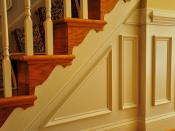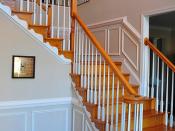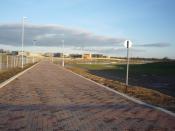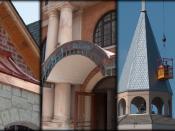IntroductionThis case of Chuang Uming (Pte) Ltd v Setron Ltd was appealed for owing to the defective tiling works carried out on the façade of a seven storey industrial building known as ÃÂHaw Par Technocentreàlocated at the junction of Commonwealth Avenue and Tanglin Halt Close, Setron Limited being the owners of the building. The architects involved were Lee Sian Teck Chartered Architects and the contractors engaged in the construction of the building were Chuang Uming (Pte) Ltd. The contract period was to last for about 50 weeks, commencing from 14 November 1990 upto 30 October 1991 although, the delay in completion of the work went upto 28 April 1992. A specialist sub contractor, Siwahin Decoration Contrcators for about 21 weeks, undertook the task of tiling the façade with ceramic tiles.
BackgroundIn mid May 1992, after two months of completion of the site, the façade proved to be faulty since the tiles began debonding and falling apart.
From June 1992 to May 1993 discussions were held regarding the same between the parties involved. Although experts were consulted in this matter, nothing materialized by the end of all these discussions. The main argument started when the contractors refused to comply with the decision of repairing the façade and blamed the architects faulty design being the cause of the debonding of tiles.
Suit No: CA 45/1999, CA 46/1999Decision Date: 01 November 1999Court: Court of AppealCounsel for the Contractors: Salem Ibrahim and Leong Why KongCounsel for the Architects: Engelin Teh SC, David Kong and Thomas SimLiterature Review(A) The Interim Certificates-On 19 February 1993 the first Interim Certificate No C18 was issued accounting for an amount of $580,933.10 being the first amount of retention due from the owners to the contractors.
-The architects disagreed with this amount since the defects of tiling wasnÃÂt accounted for.
-On 31 March 1993 another Interim Certificate C19 was issued after deducting the $49,500 representing 5% of the defects.
-No payment was being made by the owners on the above mentioned amounts.
-On 5 May 1993 the architects declared tiling of the whole façade as defective. An Interim Certificate No C 20 was issued stating an amount of $218,566.90 due from the contractors to owners after deducting $750,000, the estimated cost of rectifying the facade.
-On 13 May 1993 an Interim Certificate No C21 certified that $75,000 was erroneously deducted since the contractors owed the owners $40,259.40.
-The final sum arrived at was $621,192.50-the cost of tiling minus the retention money of $580,933.10.
(B) Proceedings-On 24 April 1993 the contractors commenced the proceedings in Suit 883/93 against the owners with the intention to claim $ 580,933.10.
-The main cause was owing to breach of contract and/or negligence.
-The contractors blamed the owners with reference to certificate numbers C18 and C19.
-The owners intern blamed the contractors for negligence and façade damagement.
-Further, the contractors blamed the architects in order to counterclaim on the architects design.
-The trial took place before Rubin J.
-The trial concluded stating that the owners were not at fault ands the claim was to be taken jointly from the architects and contractors namely due to bad design and construction works respectively.
-The amount to be claimed for damages was $1,979,526.18 after deduction of $580,933.10 of the retention sum where 20% of the sum was withheld liability for by the contractors whereas 80 % by the architects.
-The contractors and architects were also liable to pay an interest on the sum due and the costs.
(C) The appeal (key arguments)The contractors and architects appealed separately against the decision of the judge. Only the owners were a part of the contract filed by the contractors under CA 45/99 and the architects under CA 46/99 the contractors were joined as first respondents and the owners as the second respondents.
In the appeal CA 45/99 the contractors challenge the decision of the judge on the following grounds:-Firstly, they argued that the proportion of 20% was too high to be liable for.
-Secondly, the liability should be separately accounted for and not joint.
-Thirdly, they argue that the learned judge made an error in accounting for the damage.
-Fourthly, they raised a procedural point relating to the claim for interest on the second retention sum paid to them by the owners.
In the appeal CA 46/99 the architects argue on the following grounds:-Firstly, they argue that the defects were caused mainly by bad workmanship on the contractors part which leads to accounting for their liability not being as high as 80%.
-Secondly, they too argue that the liability to the owners should be separate and not joint.
-Thirdly, they argue that the owners filed to moderate their losses with respect to the claim of rentals.
-Lastly, they think they should not be held liable for lack of supervision which was to be carried out by the clerk of works that was appointed by the owners.
AnalysisIn this case initially the contractors sued the owners for not fulfilling the payment as mentioned in the Interim Certificate, within the due date. The owners very rightly turned the case over against the contractors on account of damages caused in the façade for which no action was taken even after various discussions. In my opinion, the owners were justified in every which way to do so and the learned judge passed the judgment accordingly for which the contractors and architects were held liable. Hereafter, the contractors and architects appealed against the decision of the judge for the above mentioned reasons. The dispute therefore, was regarding whether the fault of the damages was that of the architect or the contractor on grounds of either faulty design or construction. Though the main objective of the argument was who caused the damages, the arguments carried on for a long period of time as to whether the judgment passed should be jointly passed or considered separately.
In the trial judgeÃÂs findings the dispute lied mainly between the architect and contractor on the issue of liability and whether the defects were caused by poor workmanship on the contractors part or defective design owing to the architects. The causes of the debonding of tiles were as follows:-poor bedding of tiles due to insufficient pressure applied : contractors responsible-inadequate provision of tiling joints: contractors responsible-poor construction details at window sills: contractors & architects responsible-voids in the adhesive:-specifications for joints fell short of Australian & British Standards: architects responsibleThus, from the above analysis one can conclude that the tile debonding occurred due to a combination of incorrect design specification and defective construction. In my opinion the contractors and architects were equally at fault for not having carried out their performance with due contingence and although given grounds for improvement neither of the two parties took the necessary steps to help the owners when complaints of the debonding were made initially. Thus, not only were they negligent in performance of their duties initially but also failed to rectify their mistakes when given the opportunity to do so.
(A) The contractorsÃÂ argumentsThe contractors challenged the judgeÃÂs proportion of liability of 20% towards them being excessive since the clerk of works and the maximum workmanship that could have been accounted for on their behalf was only 10% since even after perfect workmanship the debonding could not have been prevented due to faulty design, thus, reversing the entire blame on the architects.
(B) The architectsÃÂ argumentsOn similar grounds the architects argue that to account for 80% of the liability was also far too high. They also argued that the code of practice as set by the Australian and British Standards was fulfilled although by the end of the argument the judge concluded that these standards were not met. To this Mrs Teh argued that the Australian and British Standards were misinterpreted by the learned judge and the second argument put forth to that was the poor workmanship being the cause of the debonding.
In accordance to the above arguments the architects seemed definitely at fault due to poor design of the tile joints but not so much so that the contractors would be justified for their poor workmanship.
Sources of EvidenceFurther, evidence and experts were called for to support the arguments. The first source of evidence brought forward by the contractors was:(1)Mr N Narendranathan, civil engineer by training with considerable experience in Singapore, Brunei and Sri Lanka. He stated that the cause was owing to insufficient spacing between tile joints which was incorrectly stated in the architects drawings. He also relied on Mr Richard BowmanÃÂs report of the Commonwealth Standards and the Industrial Research Organization of Australia. The conclusion to his findings was that the workmanship wouldnÃÂt have caused such severe damage unless specificatis were not rightly stated and although there was a slight fault on behalf of the contractors, it was negligible.
(2)Mr Paul Mundell, the regional manager of the company RAK Material Consultants Pte Ltd. Was the second expert called forward by the contractors. In his opinion the cause of the debonding was due to inadequate provision for thermal expansion.
(3)Mr Cyril Venning was the expert called for by the owners. He held a senior position in Singapore, Malaysia, Indonesia, the United Kingdom and Australia with considerable experience in civil and structural engineering. His evidence stated that the primary cause of the tile failure was owing to poor workmanship and not thermal expansion. The explanation put forth by Mr Venning was in my opinion of correct finding and was supported with pictures of the same, thus seeming most justified and flexible than other expertsÃÂ opinions. The learned judge also found Mr Venning the most ÃÂobjective expertÃÂ.
By the end of these findings the judge concluded that there was enough evidence to support the contractors lack of workmanship and also owing to the architects design the effect on the tiles would have been unavoidable and over a period of time it was bound to happen.
Hereafter, the question of liability arose where the proportion of 80% due by the architects and 20% by the contractors was suggested as unfair. The question of inadequate supervision and inspection was considered for which once again the architect was blamed for not having taken enough care of how the work was being carried out at its various stages. The arguments that followed suite by both the parties showed that the responsibility of on site supervision wasnÃÂt the architects responsibility but the clerk of worksÃÂ. Once again the cause of the debonding was taken into consideration where the judge made reference to the Civil Law Act (Cap 43, 1991 Ed) which was further referred to precedent cases namely(1)Fitzgerald v Lane & Ano(2)Nowlan v Brunswick Construction Ltd(3)Victoria University of Manchester v Hugh Wilson & OrsTo the above mentioned cases the two parties further argued on the erroneousness of the cases where the main topic of discussion once again revolved around whether the damage was done by separate breaches of contracts or a joint liability.
DamagesThe damages were compensated for towards the owner by awarding him an amount of $1,979,526.18. the items for which the losses was summed up was:-the cost of tiles-installation cost of the tiles-preliminaries-cost of associated works: expansion jointsFurther, the owners decided to put forward-compensation for the cost relating to the new façade-loss of rentalIn context to the above the owners decided to strip off the external façade of the existing tiles and re-tile it with ÃÂEleganstoneàinstead. However, they appealed only for a claim on the consultation fees and cost of preparation of the wall but not the cost of the new finish which was a fair claim to which the judge also agreed.
Secondly, the debonding of tiles and the scaffolding placed around it did not have a very pleasant visual effect which resulted in unoccupied premises. The contractors argued that the necessary steps of surrounding it with a proper structure was not taken by the owner in improving the visual aspect of the building.
Eventually, the learned judge supported the owners by claiming the loss for rentals as well.
By the end of this judgment; in my opinion, the owners received absolutely fair judgment and majority of the losses were claimed.
Also, the contractors claimed for their interest on the second retention sum.
ConclusionThe contractors appeal in CA 45/99 was dismissed and the architects appeal CA 46/99 with respect to the liability was given due consideration although the appeal for damages was dismissed.
Therefore, the judgment was passed in favor of the owners while the contractors and architects had to pay for the loss since they did not take necessary action when required and neglected their duties during the on goings as well as after completion of the work. Although given a chance they did not rectify there mistakes in time and had to pay off heavily to make up for it.
List of ReferencesChuang Uming (Pte) Ltd v Setron Ltd and Another Appeal, viewed 11 February 2007, http://lwb.lawnet.com.sg/legal/lgl/rss/landmark/[1999]_SGCA_77.html





